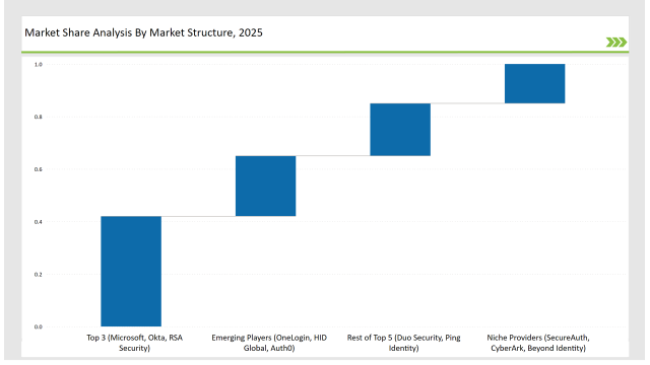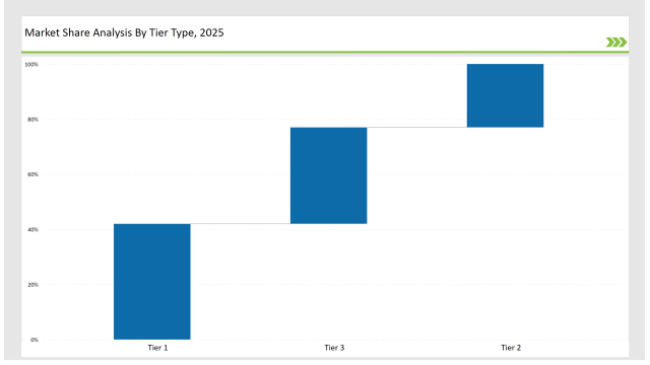As businesses and governments increasingly adopt secure authentication methods to protect digital assets, prevent identity fraud, and enhance cybersecurity, the Authentication Solutions market is rapidly growing. On the top of the market in trust & identity are Microsoft/Okta/RSA security giving them roughly 42% of the market. The companies offer MFA, IAM, and biometric security solutions. Duo Security (Cisco) and Ping Identity, who are both among the top five vendors, hold 20% of the market focusing on adaptive authentication, zero-trust security and AI-driven risk analysis.
Upstart players like OneLogin, HID Global and Auth0 cover 23% of the market, offering specialized solutions for cloud authentication, passwordless security, and mobile authentication. Niche providers, like SecureAuth, CyberArk, and Beyond Identity, have 15% market share through their focus on PAM, endpoint security, and fraud detection.

| Category | Industry Share (%) |
|---|---|
| Top 3 (Microsoft, Okta, RSA Security) | 42% |
| Rest of Top 5 (Duo Security, Ping Identity) | 20% |
| Emerging Players (OneLogin, HID Global, Auth0) | 23% |
| Niche Providers (SecureAuth, CyberArk, Beyond Identity) | 15% |
Exclusive Offer: 30% Off on Regional Reports
Get a free sample report and customize your regions for a 30% discount on your regional report!
The market remains moderately consolidated, with top players controlling between 40% and 65% of the industry. Microsoft and Okta dominate the sector, but mid-sized vendors drive innovation, particularly in SME solutions and passwordless authentication.
The Multi-Factor Authentication (MFA) segment leads the market, holding a 60% share. Stringent security regulations, rising cyber threats, and the need for zero-trust security frameworks fuel its growth. Microsoft and Okta dominate this segment with biometric authentication, adaptive security, and AI-based threat detection solutions.
AI-Driven Authentication
Predictive analytics can help AI-based credentials to identify anomalies and help prevent account takeovers, revolutionizing security. These solutions monitor user activity and patterns across devices and logins to offer proactive protection of the system.
Biometric Authentication Adoption
The convenience of biometric authentication, which includes facial recognition and fingerprint scanning, as well as its advanced security features, is leading to widespread adoption of the technology by organizations.
Cloud-Based Identity & Access Management (IAM)
Real-time authentication management is done in cloud-based IAM solutions that businesses deploy. These are integrated with enterprise applications as well and enhance security in remote work environments.
Password less Authentication
The industry is moving away from plain text passwords by leveraging biometric security, token based authentication and cryptographic keys which consequently brings down phishing and enhance user experience.
Zero-Trust Security Model
Implementing zero-trust authentication guarantees ongoing verification of users and devices, blocking unauthorized access.
Blockchain-Based Authentication
Blockchain technology is being applied by companies to enable identity verification and secure decentralized authentication records that cannot be modified.
Integration with Regulatory Compliance
Businesses are supporting authentication solutions with regulatory frameworks such as GDPR, HIPAA and PCI-DSS to ensure compliance and data security.

| Tier | Tier 1 |
|---|---|
| Vendors | Microsoft, Okta, RSA Security |
| Consolidated Market Share (%) | 42% |
| Tier | Tier 2 |
|---|---|
| Vendors | Duo Security, Ping Identity, OneLogin |
| Consolidated Market Share (%) | 23% |
| Tier | Tier 3 |
|---|---|
| Vendors | HID Global, Auth0, SecureAuth, CyberArk, Beyond Identity |
| Consolidated Market Share (%) | 35% |
Check Free Sample Report & Save 40%!
Select your niche segments and personalize your insights for smart savings. Cut costs now!
| Vendor | Key Focus |
|---|---|
| Microsoft | Passwordless authentication and AI-driven risk analysis. |
| Okta | Adaptive authentication and zero-trust security. |
| RSA Security | AI-powered biometric authentication and identity management. |
| Duo Security | Zero-trust authentication and mobile security. |
| Ping Identity | AI-based user behavior analytics and decentralized authentication. |
| OneLogin | Cloud-based IAM and passwordless security. |
| HID Global | Physical and digital identity authentication. |
| Auth | Developer-friendly authentication APIs. |
| SecureAuth | AI-driven fraud prevention and risk-based authentication. |
| CyberArk | Privileged access management and endpoint security. |
| Beyond Identity | Passwordless authentication and cryptographic security. |
As businesses focus on mitigating cyber threats, vendors must enhance AI-driven authentication capabilities. Therefore, machine learning models will be developed as per the usage to improve the accuracy of detecting fake log-in attempts and identity theft. Companies will reduce friction while maintaining security as they further automate authentication processes through AI-driven risk analysis and adaptive authentication. The future is focused on cloud-based IAM, which can easily mesh with enterprise security ecosystems.
Emerging markets offer great potential for growth. Focus on regional compliance and multilingual authentication solutions, jurisdiction specific security policies.
Microsoft, Okta, and RSA Security lead with a 42% market share.
OneLogin, HID Global, and Auth0 control 23% of the market.
Market concentration remains moderate, with the top 10 players controlling between 60% and 70% of the industry.
Explore Digital Transformation Insights
View Reports
Thank you!
You will receive an email from our Business Development Manager. Please be sure to check your SPAM/JUNK folder too.